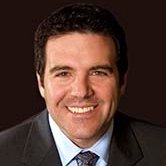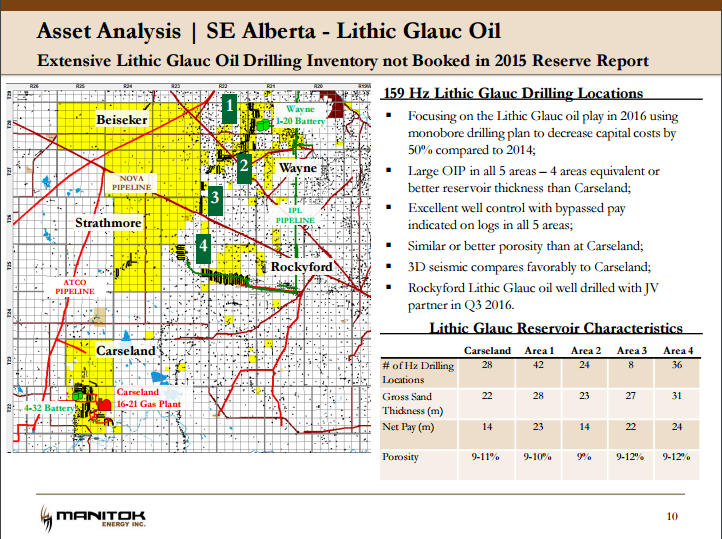Exploration Wells at Rockyford Successfully Producing, Cleanout Ongoing
Manitok Energy (ticker: MEI) announced initial production rates from a successfully drilled horizontal Lithic Glauconitic exploration well in the Rockyford area of Southeastern Alberta. The company also announced that it spud a horizontal Lithic Glauc well in the nearby Carseland area on September 20.
Completed in August, the Rockyford well was tied-in after two days of production testing and has been flowing since the end of the month. Over the initial 17-day period, the well averaged 396 boe/d, comprised of 56 bbls/d of 45 to 55 API light oil, 1.8 Mmcf/d of natural gas, and 36 bbls/d of NGLs. Its production rate has improved 68% due to frac fluid recovery and the well is still yielding about 80 bbls/d of fluid.
“Because of the well’s depth of 1700 meters and its location in the trend, we know there is more gas which will provide lift. It could take one to three months to clean out the remaining fracking fluid in the well during which it could always go flat,” said Manitok President and CEO Massimo Geremia in an exclusive interview with Oil and Gas 360®.
These build on the first successful horizontal Lithic Glauc wells the company drilled at Carseland in 2014, which are currently flowing at a combined rate of 900 boe/d and have produced 350,000 boe to date.
“This success further proves up the trend and adds 25 locations to our inventory. We’ve drilled more of the Lithic Glauc formation along a different trend, we’ve had great success at Carseland and now at Rockyford, and we’re planning to drill another well further north in Wayne in the fourth quarter,” Geremia said.
Rockyford Well Costs Lowered 52% from 2014
The well was drilled as part of a farm-out agreement announced in November 2015, in which Manitok has a 50% working interest. It is the company’s first horizontal Lithic Glauconitic well to incorporate a monobore drilling plan, which is intended to reduce capital costs.
Drilling and completion costs for the Rockyford well were approximately $1.3 million, a 52% decrease from $2.7 million spent for the same operation in 2014. This a lower than the $2.8 to 3 million the company was spending two years ago and the $1.8 or 1.9 million present costs that were anticipated then.
Monobore Technology a “Stair-Step Change” for Company
“While drilling and completions costs have been lower across the industry regardless of technology, monobore reduces drilling times 25 to 30%, allowing wells to be completed in a shorter time frame,” Geremia said. “If we can bring it up to scale, we feel that this is a stair step change for us in terms of well economics and reserves, which will greatly enhance our SE Alberta land values.”

Manitok President and CEO Massimo Geremia
Using older drilling technologies, wells first had to be set with surface casing for about 100 meters down, followed by intermediate down to the heel of the horizontal before the horizontal leg could be drilled out. Putting the intermediate casing in, cementing it off, and allowing it to dry often took up to several days.
“With monobore, you go straight from surface to toe, you don’t stop to put intermediate casing in, you drill right to toe and jam all the casing in right down to the end, cement off and then do your completion. This takes three to four days off of a ten-day drill time, which is substantial,” explained Geremia.
The Lithic Glauc play is 1500-1700 meters deep in Manitok’s area of operations. Asked if the smaller amounts of cemented casing used in monobore compromised structural integrity, Geremia responded that the company was confident after examining area well logs and drilling records that the risk was small if the right drilling fluid was used.
“Right now, guys are developing better muds to hold back the rock while we’re drilling, so all the stuff is advancing to support drilling monobore down to 2500 to 3000 m.”
Monobore to be used throughout SE Alberta
The company intends to use the monobore drilling plan for all of its horizontal Lithic Glauc wells in its 2016 drilling program. The first two wells of this program are planned for the Carseland area with a third in the Wayne area, all to be completed in the fourth quarter of 2016 at 100% working interest.

Based on production to date from the two areas as well as 3D seismic and well log data, the company believes there are about 28 Carseland horizontal Lithic Glauc drilling locations at 100% working interest and 23 Rockyford horizontal locations, where it has the option to participate up to a 50% working interest in each well through the farm-out agreement with its partner. Overall, the company currently believes there are a total of 150 drilling locations on its land in SE Alberta.
Company Gearing Up to Raise Capital Quickly
The company also filed a preliminary base shelf prospectus on September 16 for the offering of up to CAD $150 million of common shares, preferred shares, debt securities, subscription receipts, warrants, units or any combination thereof over the prospectus’s 25-month period. The prospectus will enable the company to quickly access capital markets when conditions are optimal.


